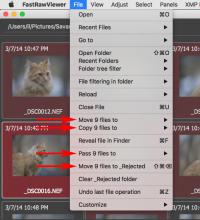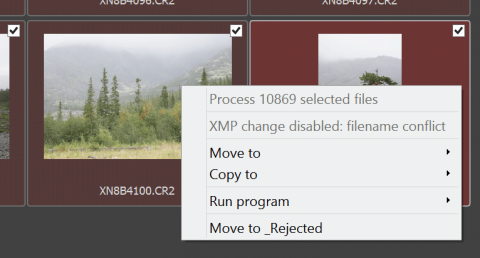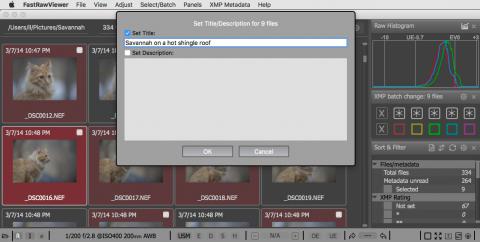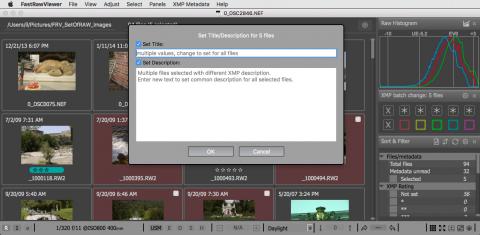Operations with Multiple Files
Selecting/marking files
While developing FastRawViewer we realized that the standard way of selecting files is not to our liking:
- An accidental mouse click destroys the whole selection
- The currently displayed file is always included in the selection, and that is not necessarily convenient
Because of this, in FastRawViewer versions 1.3.0 – 1.4.6 we used a different, free of those inconveniences, method for selecting files; there is a thing with it, however: to add a file to selection one needs either to use Ctrl-Click, or to click on a checkbox in the upper right corner of the thumbnail.
Starting with FastRawViewer version 1.4.7, we also support the standard method of selecting files, the same as the one used in Windows Explorer/Mac Finder. To switch to this mode, uncheck the box in Preferences – Grid/Filmstrip – Advanced selection mode: accidental click does not ruin selection.
Advanced selection mode (enabled by default)
To mark a file for group operations in Grid View (or in the Filmstrip), you can do one of the following:
- Ctrl-Click on the file preview thumbnail.
- Set a checkmark in a checkbox in the upper-right corner of the preview thumbnail (the checkbox appears for the files that are currently unmarked when you hover a mouse over its preview; the checkbox is permanently visible for those files which are already marked).
- Shift-Click in Grid View/Filmstrip selects a consecutive group of images:
- the images selected start from the last one whose selection status was changed (using Ctrl-Click or the keyboard), and go up to the one that was Shift-Click'ed
- if there is no image whose selection status was changed (like it is in the cases when the last-clicked file was moved, or a new working folder was selected), the Shift-Click operation uses the first file instead; the selected range starts with the first file and goes to the one that was Shift-Click'ed
(the behavior of Shift-Click can be changed through the hidden setting ShiftClickSelectionMode, see the “Additional Setting” section below).
- Through the actions in Menu – Select
- (De)select and move to next – reverses the mark status and navigates to the next file.
- Move to prev. and (de)select – navigates to previous file and reverses its mark status.
- Select All, Invert Selection, Deselect All.
- Save Selection to file – saves the list of marked files to a text file on the disc.
- Load/Append selection from file – loads the list of marked files from the previous bullet and marks the corresponding files for the load operation or adds to the list of the currently-marked files for the append operation.
The previews of the marked files have a different background color:
This color can be changed through Preferences – Interface – Selected files background.
If some files with the same name (but different extensions, such as CR2 / DNG pair) are highlighted, then the operations to change the orientation or to change / set ratings or labels will be disabled: it is impossible to apply such operations over a pair of files files with the same name and different extensions, because for such a pair only one XMP file can exist:
To allow XMP operations, disable the setting "XMP settings - Disable batch XMP operations if files with same name are selected". If it is turned off, the XMP files will be created for all selected files, but because of the name conflict only the last recorded file will contain actual data.
Standard Selection mode
The standard mode of selecting files works the same way as selecting files in Windows Explorer/Mac Finder does:
- Mouse click (without pressing any additional keys / modifiers) leaves only the «clicked» file selected
- Ctrl-Click – switches the file selection mode
- Shift-Click, Shift-arrow – extends the selected area.
Actions on marked/selected files
Context menus
When clicking on any of the selected files, a context menu that displays possible actions over the group appears.
Program menus/hotkeys
Starting with version 1.4.6, FastRawViewer uses the same hotkeys/menu items for operations with several files as for single files.
Since in Advanced selection mode the current file may be not a part of the selection, we introduced a special setting to make the behavior determined:
Preferences - Grid/Filmstrip - If the current file is not in the group of selected files, single-file shortcuts will work with, with the options:
- Current file - the buttons to act on files work on the current file
- Selected group - works with the selected group
- Both - the current file is implicitly added to the selected group.When turning on Single file keys works for multiple...:
Default actions, specifically:
- Menu – File – Copy, Move, Pass to (program), Move to Rejected
- Menu – Adjust – Rotate/Flip
- Menu – XMP Metadata
can work with one file or with several, depending on the context:
- In Single-file View Mode, the actions always work with the current file, not the group.
- In Grid View Mode, if there are selected files, the actions will work with the group:

- If the current file is not present (e.g. folder just opened) or is in the group of selected files
- If the current file isn't in the group of selected files, but the setting If the current file... is set to Selected group or Both.
- Group mode is indicated in the menu:
- File: Move, Copy, "Move to Rejected", Run - instead of the filename, you will see "Move (Copy, Pass to) NN files to"
- Adjust: the header "Rotate NN selected files" appears above the Rotate group; and "Adjust filename" above the edit single file (In Single file View Mode) group.
- XMP Metadata: the first line of the menu becomes the "Rate/Label nn selected files" header
- Group mode is indicated in the XMP Metadata panel and in the application's bottom bar (please see the picture below: single mode - the left part, group mode - the right part):
- The panel header changes to XMP Batch change: NN files
- The asterisks change to snowflakes
- The filled-in square marks change to colored borders
On the picture below, work with a single file is displayed on the left, work with multiple files is displayed on the right:
- If the selected group has identical ratings/labels, then the corresponding snowflakes/borders will be highlighted (picture below, on the left), if they’re non-identical (or unknown, see the next point), then they won’t be (on the right).
- If for part of the files, the metadata hasn't been read yet, then if there are fewer than 30 such files, they will be read. If there are more, then the "common rating/common label" will be unknown.
The Title/Description fields are displayed the same as for ratings/labels:
- If they are the same for all selected files, then a field that matches the contents of all of the files will be displayed in the XMP/Metadata panel.
- If they are different (or unknown because the metadata hasn’t been read), multiple values is displayed there instead.
If, when working with a group of files, with the setting XMP -> Disable batch XMP operations if files with same name are selected turned on (default value), then if in the group of selected files there are files with identical names (for example file.CR2 and file.DNG), then XMP operations (rotation, rating, label, title, description) will be restricted (in fact, disabled).
XMP operation restriction mode (due to a naming conflict) is indicated:
- In the Adjust and XMP menu, with the header 'XMP change disabled: filename conflict'
- In the header of the XMP Metadata panel (XMP Change disabled), and textually in place of the Title/Description fields.
When turning on Single file keys works for multiple files too mode, the (old) buttons for group actions disappear from:
- The keyboard shortcuts editor (Ctrl-K)
- Current keyboard macros help (F1)
The check for one button is assigned to several actions happens at the start of the application.
Batch editing of Title/Description
To do so, in Alternate multiple files processing mode (see next chapter) use the default menu (XMP Metadata), the default hotkey (Alt-D), the context menu for a file group, or by clicking on the Title/Description space in the XMP Metadata panel.
If the new mode has been turned off, then group editing appears in the Select/Batch menu.
The editing dialogue differs from Title/Description editing for a single file
- Each of the two fields has an additional checkbox (when first used, it's not checked - afterwards, it's saved for the duration of one session)
- If the checkbox isn't checked, then the corresponding field can't be edited and it won't be changed for file groups.
If a group of selected files has the same Title/Description, then they will be displayed in the editing dialog. If different, then it will say in the dialog (as a gray text in the editing panels) that the values are different.
Operations with selected files: compatibility mode with older versions
When turning off the setting Preferences – Interface – Grid/Filmstrip – Single file keys work for multiple files too, FastRawViewer will work in a mode compatible with versions 1.3-1.4.3:
If, however, one turns on Single file keys works for multiple files too mode:
- Menu -> Select is renamed to Menu -> Select/Batch
- Actions over groups of files appear in the menu.
- The corresponding actions appear in:
- Hotkey settings(Ctrl-K)
- Help with current hotkeys (F1)
- The “one button is assigned to several actions” check that runs at program start.
- Under default settings, no group action has any hotkey, they will need to be set manually.
The behavior of context menus doesn’t change.
Undo: Reversing File Operations
The Menu – File – Undo can reverse the last file operation (in reverse order of their completion).
The undo is possible for:
- Setting a rating and/or label;
- Copy operation;
- Move operation;
- Moving to a _Rejected subfolder (“deletion”).
It is also possible to undo the rotation of the group of marked files (there is no undo for the rotation of a single file – you can simply rotate it back).
After cancelling a move operation (to another folder or into _Rejected) for a group of files, the original rating for that group will be restored. When cancelling other operations, the rating will not be restored.









